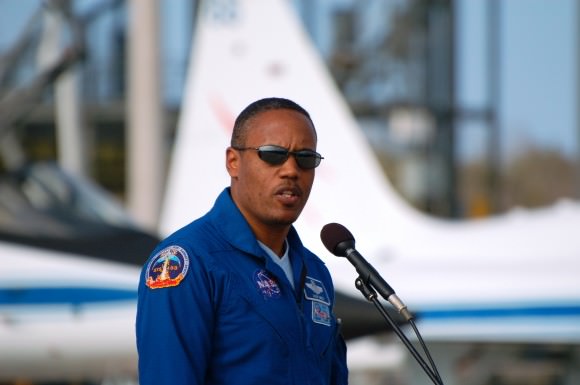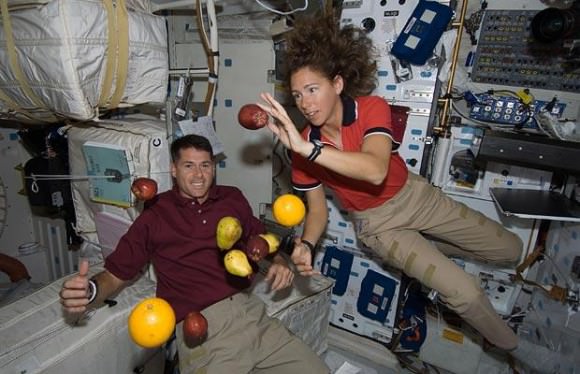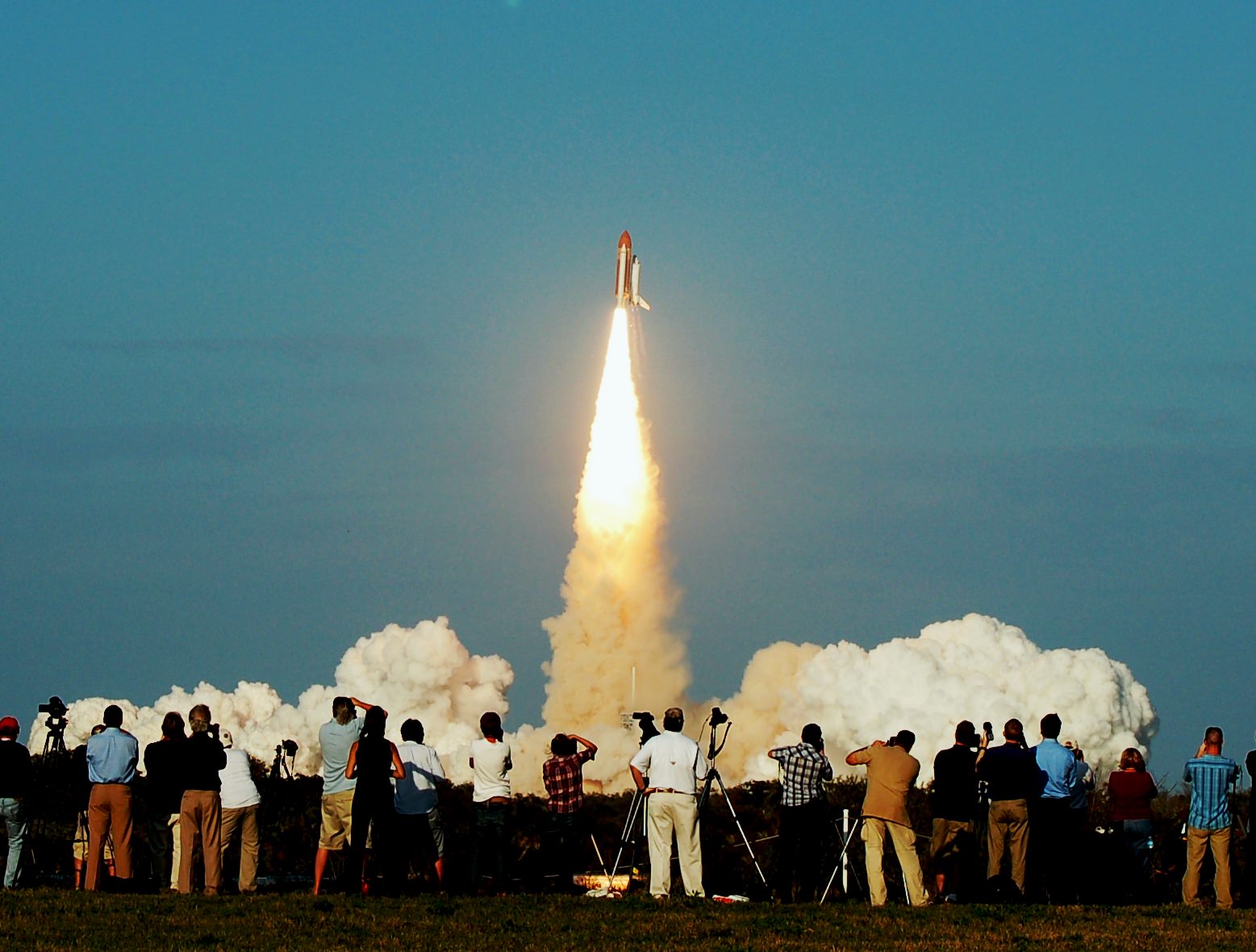[/caption]
When it comes to space flight, the media, politicians and the public tend to focus on who was “first.” Many point to the fact that the Soviet Union was first to send both a satellite and man into orbit as the impetus behind the U.S. into the new frontier. However, the “lasts” are often lost to history, forgotten in the dusty pages of some biographer’s notes. As the shuttle era closes, there are several lasts that, so far, have gone unmentioned. More importantly, the program, as a whole, has been an incredibly powerful engine for change – both within the U.S. and abroad.
Alvin Drew is the last African-American currently scheduled to fly in the shuttle program. Additionally, there is one other last that may or may not be highlighted (if NASA gets the necessary funding for the mission) – the last woman to fly in the shuttle program – Sandra “Sandy” Magnus on STS-135. Although NASA has declared STS-135 an official mission, the funding needed to fly it, has yet to be approved.

These two “lasts” may or may not be noted by the media, many of whom give the appearance of looking down on the program. The shuttle, as Bob Crippen once said is often “bad-mouthed” for not living up the expectations laid out at the beginning of the program. Perhaps, in time, the shuttle program will be remembered as what it was – an engine that worked to remove many social barriers. The shuttle era could, one day, be regarded as the program that opened space flight to people of all races and nations.
The number of nations that have flown astronauts onboard NASA’s fleet of shuttles is far more expansive than most think. Canada, Belgium, France, Germany, Italy, the Netherlands, Spain, Switzerland, Israel, Japan, Mexico, Russia, Saudi Arabia and the Ukraine have all flown astronauts aboard the space shuttle.
During the Mercury, Gemini and Apollo Programs the crews were universally white and male. With the shuttle’s capacity for larger crews – that dynamic changed. The U.S. flew its first woman, Sally Ride, in 1984 (the Soviet Union flew its first woman, Valentina Tereshkova in 1963) the first African-American, Guy Bluford also flew that year. After that the backgrounds of the astronauts who flew on the shuttle continued to diversify.

The first female pilot, Eileen Collins, flew on board STS-63 – she would go on to become the first female commander – and to return NASA to flight after the Columbia disaster on STS-114 in 2005. Charles Bolden, an African-American, commanded the first joint Russian/American shuttle mission (mission STS-61 on Discovery) and would go on to become the first African-American NASA administrator when he was selected in 2009. These are just two of numerous examples of how the shuttle has empowered different genders and races.
So while Drew’s and Magnus’ place in history may not be well remembered, those that paved the way for them as well as the shuttle’s capabilities made it all possible. Time will tell if the shuttle will be remembered for its shortcomings or if it will be remembered for allowing astronauts of all stripes to fly, for the Hubble Space Telescope to be deployed and serviced, for the International Space Station to be built and for all the other positive things that the shuttle made possible since it first flew in April of 1981.
“The shuttle has flown on such a routine basis for the past 30 years that many Americans may not realize the contributions it has made for all humankind,” said Candrea Thomas a NASA public affairs officer. “When the shuttles stop flying, I believe Americans will remember all the wonderful technologies and advancements that these amazing spacecraft, and the diverse group of people who worked on them, made possible.”


I used to fly sailplanes when I was younger and able-bodied. I will always remember the shuttle as the most incredible (and expensive) glider ever built, and I don’t believe that’s going to change in my lifetime. Yes, imagine that: it actually is a glider. It’s being towed to a great altitude by a powered craft, and then it glides down – just like the gliders we had at the college sports club.
I think it’s sad that even now, as the program draws to a close people refuse to aknowledge how much of a failure it was. I don’t say this to deride the work of the engineers, astronauts and just about everyone else working on the program. I’m sure most of them did the best they could under the circumstances.
That doesn’t change the fact that 2 shuttles were destroyed in 132 flights, even though managers claimed the chances of an accident were less than 1:10000. Or that the total cost is over $150 billion (!) dollars with relatively little impact on science or the future of space exploration.
I know it’s a cliche but if even people who actually care about human spaceflight refuse to face reality the future will be more of the same. That is a few small successes at enourmous costs and little substantial progress.
“…people refuse to acknowledge how much of a failure it was.”
Wow. Even I disagree with this, and people know my usual negative US rhetoric!
IMO, the Space Shuttle was a great technical success. It certainly developed computer systems and placed great observatories like in 1990 the Hubble Space Telescope, which by repairs and upgrades with improved instrumentation by five different shuttle missions, extended the life of the science — and it is still going twenty-one years later! Heck. That alone was worth the entire program!
Yet whilst it is true that it could have probably have been done in many different ways, no one has a crystal ball to determine what would happen in the future. If you truly want to be introspective, you might like at the whole US economy. How the heck you ended up with trillions of dollars in government debt (let alone the current interest payments) has really got me stumped — and yet everyone pretends it isn’t really happening. Frankly it is just a matter of reorganising the priorities, putting things on hold for a little while to get the show back on the rails.
IMO, your complaint is made in hindsight. At the time when the Space Shuttle was being developed, they honestly thought it was the best way to go. In this view, I think your being just a tiny tad too harsh!
correction: I meant; “you might like TO LOOK AT at the whole US economy”
“IMO, the Space Shuttle was a great technical success. It certainly developed computer systems and placed great observatories like in 1990 the Hubble Space Telescope, which by repairs and upgrades with improved instrumentation by five different shuttle missions, extended the life of the science — and it is still going twenty-one years later! Heck. That alone was worth the entire program!”
No, it isn’t. I kinda feel bad because I did want to include the Hubble repair mission as one of the significant successes of the Shuttle program.
Launching Hubble and Chandra was important too, although something similar probably would have been done without the Shuttle too, as was the case for Spitzer.
So yes, the Shuttle program deserves part of the credit for all the great science that has come from Chandra and especially Hubble. But really only a small part and it doesn’t even come close to justifying the cost.
“IMO, your complaint is made in hindsight. At the time when the Space Shuttle was being developed, they honestly thought it was the best way to go. In this view, I think your being just a tiny tad too harsh!”
The program should never have been restarted after the Challanger accident. All the technical problems were already known and it was obvious the Shuttle couldn’t be operated safely AND cheaply. Everything that was needed to make a good decision was known.
Why was the wrong decision taken anyway? The first step to answering that question is to actually admit that it was the wrong decision. Not just in hindsight: it was wrong given the facts known at the time.
I actually think the answer has a wider relevance. How do you get support for a wasteful program? Not just from people who directly benefit from it, but even from the wider population? And I feel like the traditional answers of lobbying, corruption and ignorance is incomplete.
Gee. You make some excellent solid points here.
In the end, the answer is probably somewhere between our two positions. I’m sure you and I could slug it out with many points supporting our positions, but it would end up as not very useful.
Perhaps the Shuttle could be put down to just gaining more information for some future space endeavour.
Cheers.
Note: A counter argument to your ideas is that we should have spent more money on the Shuttles to make them safer and more durable. After all they were promised to be an highly regular economic reusable spacecraft but the budget for their development was slowly reduced.
Sorry, but I have to agree with effortless here.
You could have spent all the money you wanted and not got around this basic fact: the technology to build the STS as originally intended (cheap, reliable and safe) doesn’t exist to this day. This was a known fact right from the first missions, when it got obvious repairs between flights would be routinely long and expensive. I’m old enough to remember this.
To quote (again) astronaut P. Nespoli (I think), the shuttles are retired because they’re too _new_, not too old.
It’s not much use anyway to go on rambling about it now that it’s over, but at least (as little as I care for the manned space programs) it would be good to be sure lessons were learned. I’m afraid they were not.
Ok my .02 worth.
Yes the shuttles price tag has always been inexcusably high. That my friends is NASA, everything NASA does is grossly expensive. India’s chandrayaan moon mission which put a satellite with 11 instruments in orbit around the moon only cost $80 million. NASA can’t draw a mission up on paper for that so we’ll but cost aside for this discussion.
I would argue that the shuttle has been a remarkable success for an experimental aircraft. Let’s remember the shuttle has only been flight tested approx. 140 times. Compare that to the f-22 or any other 5th generation fighter jet and it’s no wonder we lost 2 of them. 140 flights really isn’t enough to establish a performance envelope for any state of the art aircraft.